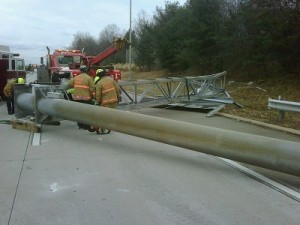A few weeks ago, in Northern Virginia, a 30 foot highway sign fell onto I-66 and landed on a passing pickup truck. Fortunately, no one was hurt, but it drew media attention and caused motorists in the area to wonder about the safety of other signs and the transportation network in general.

According to Virginia Department of Transportation officials, there are more than 260 similar signs hanging over roads throughout Northern Virginia. VDOT mobilized crews immediately following the incident but 10 days after the sign fell, only about 25 of the signs had been inspected and three (with cracked bolts) had been removed. According to VDOT, signs like the one that fell are inspected every five years—the one that fell was last inspected in 2007.
State DOT inspectors across the country have a big job, with serious safety implications if they miss something. Not only do they have to worry about the signs hanging from overpasses and along highways, but also about the overall safety and reliability of bridges and roads.
To say this workload is overwhelming is an understatement—just consider the 260 signs in Northern Virginia that need to be inspected and those are just the signs similar to the one that fell. It took ten days to inspect 25 signs—VDOT hopes to speed up the process by adding workers to the crew but at the rate they are going it could take months to complete the work.
What if state DOTs were able to take a more proactive approach to these inspections? Instead of being placed in a reactionary mode and working as fast as possible to find the faulty signs, what if the inspectors knew which signs needed immediate attention and could direct work crews to conduct those repairs first?
Having the ability to take a proactive approach with maintenance and asset management through predictive analytics, state DOT inspectors would know which bridges, signs and roads needed repair first and could prioritize the dispatch of work crews accordingly. This would allow them to prioritize not only daily work, but also long range transportation planning. By collecting data on all aspects of each asset like height, weight, type of materials, condition of joints, bolts and reflective material for signs and volume for roads and bridges, state DOTs could apply data analytics to determine and target maintenance efforts more effectively and efficiently.
As my colleague, Bill Coleman blogged about a few months ago, when government agencies are able to manage their assets (roads, bridges, signs, and equipment) by using predictive analytics, they can keep public confidence high and more importantly, in the case of the transportation system, keep it moving safely and reliably.

1 Comment
Pingback: Will the world get the America it needs? - SAS Voices